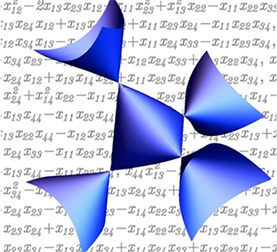

The project will be centered around investigating the structure of higher Fano manifolds. Leadership: Carolina Araujo, (IMPA), Roya Beheshti (Washington University) & Ana-Maria Castravet (University of Versailles, France) They should also address their familiarity with the suggested prerequisites. In their personal statements, applicants should rank in order their top three choices of projects. Several of the proposed projects extensively involve experimentation and computation, which will increase the likelihood that concrete progress is made over the course of five days and provide useful training in computational mathematics. The groups will work on open-ended projects in diverse areas of current interest, including moduli spaces and combinatorics, degenerations, and birational geometry. Successful applicants will be assigned to a group based on their research interests.
#ALGEBRAIC GEOMETRY SERIES#
This workshop capitalizes on momentum from a series of recent events for women in algebraic geometry, starting in 2015 with the IAS Program for Women in Mathematics on algebraic geometry.

The goals of this workshop are: to advance the frontiers of modern algebraic geometry, including through explicit computations and experimentation, and to strengthen the community of women and non-binary mathematicians working in algebraic geometry. Section 1 is recommended reading in preparation for the school the rest of the paper may be best left until after the school.The Women in Algebraic Geometry Collaborative Research Workshop will bring together researchers in algebraic geometry to work in groups of 4-6, each led by one or two senior mathematicians. DG quotients of DG categories This (essentially self-contained) paper focuses on quotients and localization (which, in particular, is necessary to define derived categories).

Generalities on DG categories The notes (only 17 pages!) summarize properties of dg categories for future applications The functor of points approach to algebraic geometry as in chapter VI " Schemes and Functors" of Eisenbud and Harris ( The Geometry of Schemes).For example, Rezk ( Introduction to Quasicategories), Groth ( A Short Course on Infinity-Categories), Riehl and Verity ( Elements of Infinity-Category Theory, alternate), Cisinski ( Higher Categories and Homotopical Algebra, alternate, errata), or Land ( Introduction to Infinity-Categories). Some familiarity with infinity-categories would be helpful.Familiar with basic objects of geometric representation theory, such as constructible sheaves and representations of algebraic groups.(Chapter 10 of Weibel’s book introduces to derived categories it is essentially independent from Chapters 6–9.) Traditional references on these topics would be Hartshorne ( Algebraic Geometry), particularly the first 3 chapters, and Weibel ( An Introduction to Homological Algebra, errata) particularly Chapters 1–5 and 10.The main prerequisite is familiarity with derived categories in algebraic geometry.
#ALGEBRAIC GEOMETRY FREE#
There will also be discussion sessions where interaction will be more free form and would cover higher-level topics, making the material exciting for advanced students while also provided less advanced students with a broader view of the field. The afternoons will consist of problem sessions in which students will be given exercises directly related to the course subject. Two lectures will be held in the mornings. Our goal is to explain the key ideas and concepts, while trying to keep technicalities to a minimum. The school is built around two related courses on geometric (‘derived spaces’) and categorical (‘derived categories’) aspects of the theory. The school serves as an introduction to these techniques, focusing on their applications.

The result is a powerful set of new tools, useful both within algebraic geometry and in related areas. This requires recasting the very foundations of the field: rings have to be replaced by differential graded algebras (or other forms of derived rings), categories by higher categories, and so on. Schur quartic x 4−x圓 = z 4−zu3 and several of the 64 lines that it containsĭerived algebraic geometry is an ‘update’ of algebraic geometry using ‘derived’ (roughly speaking, homological) techniques.


 0 kommentar(er)
0 kommentar(er)
